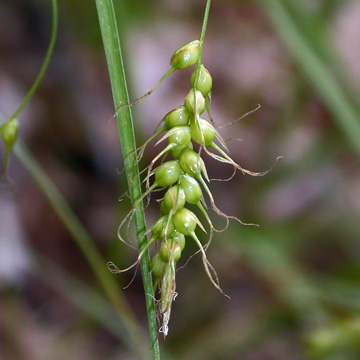

Carex sprengelii - (image 1 of 3)
Taxonomy
Family: Cyperaceae
Section Hymenochlaenae
Synonymous with C. longirostris Torr.
Habitat
Dry to mesic woods, meadows, rocky ledges, river banks, usually in calcareous soils.
Associates
Distribution
New Brunswick to British Columbia, south to NJ, IA, and CO.
Morphology
Plants cespitose, the stems 40-80 cm, clustered on a stout, short, or somewhat elongate rhizome covered by dense brown fibers representing old leaf remains; leaves cauline as well as basal, elongate, mostly 1.5-4 mm wide; basal sheath fibrous; terminal 1-2 spikes staminate or with a few basal perigynia, 1-2 cm, the others 2-4, pistillate or the upper with a few distal staminate flowers, 1.5-3.5 cm, 10-30-flowered, not crowded, at least the lower one on long, capillary peduncles; lowest bract with a sheathing base 1-10 mm and a long, slender blade, the others more reduced and often sheathless; pistillate scales narrow, acute or acuminate, pale, mostly scarious or hyaline, often scabrous along the midvein, surpassing the body of the perigynium; perigynia 4.1-7.7 mm, the body broadly ellipsoid or ellipsoid-obovoid, 2-nerved, 2.2-3.8 mm long, abruptly contracted to a slender, softly bidentate beak 1.7-4 mm long; achene trigonous, the style-base persistent and often contorted.
Notes
Fruiting late May to mid-July
Wetland indicator: FAC
An attractive species that often forms clumps on boulders in limestone woods, apparently also common on high terraces or sloping banks of rivers.
References
Ball, P.W. and A.A. Reznicek. 2002. Carex, In: Flora of North America Editorial Committee, Eds. Flora of North America North of Mexico. Volume 23. Oxford University Press, New York.
Gleason, Henry A. and A. Cronquist. 1991. Manual of Vascular Plants of
Northeastern United States and Adjacent Canada. Second Ed.
The New York Botanical Garden. Bronx, NY
|
© Michael Hough 2018 |